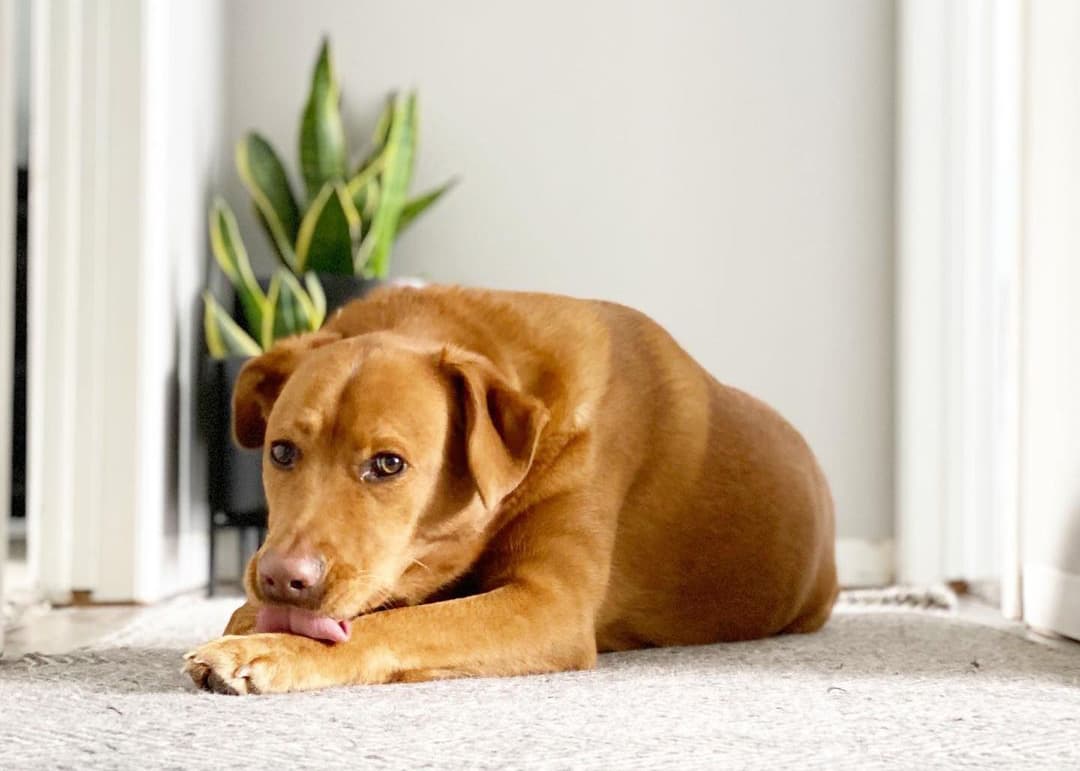Have you ever wondered why dogs love to show off their humping skills, even in the most inconvenient or embarrassing situations?
If you’re a dog owner or simply a fan of these furry creatures, you’ve probably witnessed this peculiar behavior at the dog park, during a playdate, or even while walking down the street.
It’s hard not to chuckle when dogs engage in this seemingly hilarious – yet somewhat awkward – spectacle.
But what’s the motivation behind these humping escapades?
Read on to find the answer to the question: Why do dogs hump other dogs?
Why Do Dogs Hump Other Dogs?
Dogs humping other dogs can be a surprisingly common behavior you may witness at the park or even in your own home.
While it may seem odd or even embarrassing, there is actually a multitude of reasons why dogs engage in this behavior.
Curious?
Here are some of the possible explanations behind this seemingly peculiar behavior.
1. Dominance: Firstly, humping is a natural instinct for dogs, especially when they are young or feeling excited.
It is a way for them to display dominance or establish their place in a social hierarchy.
By mounting another dog, they are asserting their position and communicating to other canines around them.
It’s like a non-verbal way of saying, “Hey, I’m in charge here!”
So, if you notice your dog humping another dog, it’s likely just their way of expressing their alpha tendencies.
2. Playfulness and Excitement: Believe it or not, humping can sometimes be a part of playful interactions among dogs.
It’s not uncommon for a dog to start humping out of sheer excitement during playtime, especially when they are engaging in rough and tumble activities.
Sometimes, dogs use humping as a playful way to initiate interaction with other dogs.
Keep in mind, though, that not all dogs enjoy being humped, so it’s important to monitor their behavior and intervene if necessary.
3. Social Communication: Dogs are highly social creatures, and humping can also serve as a form of communication within their social interactions.
For instance, a dog may hump another as a way to assert dominance or establish their position within the pack hierarchy.
Similarly, humping can sometimes be a way for dogs to signal submission and an attempt to appease a more dominant dog.
These social messages are usually conveyed through body language and humping serves as an additional tool to express their intentions.
4. Sexual Motivation: Yes, dogs can experience sexual arousal and humping is a way for them to release that energy.
It’s important to note that this behavior is not limited to male dogs only; females can also engage in humping.
It doesn’t necessarily mean that they are always looking for mating opportunities.
Sometimes, their hormones simply get the better of them, and they resort to humping as a way to alleviate their sexual frustration.
5. Stress Relief and Anxiety: Surprisingly, humping can also be a response to stress or anxiety in dogs.
Similar to how some humans bite their nails or fidget when nervous, dogs may resort to humping as a way to cope with their emotional state.
It can provide a sense of comfort or relief during stressful situations.
So if you notice your dog frequently humping in certain environments or when encountering new stimuli, it might be a sign that they are feeling anxious or overwhelmed.
Practical Tips for Managing and Discouraging Inappropriate Humping among Dogs
It’s vital to recognize that humping is a normal behavior in dogs.
It’s their way of establishing dominance, expressing excitement, or even seeking attention.
However, if this behavior becomes excessive or uncomfortable for either dog involved, it’s time to intervene.
One effective method is redirection.
When you notice your dog starting to hump, calmly redirect their focus onto a toy or another engaging activity.
This helps reinforce positive behavior and distracts them from the urge to hump.
Maintaining a calm and structured environment is also crucial in managing inappropriate humping.
Dogs may engage in this behavior when they are overstimulated or anxious.
Creating a routine that includes regular exercise, mental stimulation, and sufficient rest will help ensure that your furry friend remains balanced and less likely to engage in humping behaviors.
Additionally, providing a safe space for your dog to retreat to when they feel overwhelmed can be beneficial.
This could be a crate, a designated area, or a comfortable bed where they can relax and decompress.
Remember to always approach the issue with patience and consistency.
While it may take time to address inappropriate humping, with proper training and positive reinforcement, you can help your dog overcome this behavior.
If you find that the problem persists despite your efforts, it’s recommended to consult with a professional dog trainer or behaviorist who can provide tailored guidance and support.
By understanding the reasons behind dog humping and applying these practical tips, you’ll be well on your way to managing and discouraging this behavior, ensuring a happier and more harmonious relationship with your furry friend.
Training, Socialization, and Positive Redirecting to Build a Healthy Environment
In the world of canine behavior, we’ve all witnessed our furry friends engaging in some peculiar activities.
One common behavior that can leave dog owners perplexed is the infamous act of humping.
Before jumping to conclusions or feeling embarrassed about your pup’s actions, it’s essential to understand why dogs hump other dogs in the first place.
By exploring the intricacies of training, socialization, and positive redirecting, we can pave the way for a healthier environment for our beloved pets.
Training plays a pivotal role in a dog’s life, aiding in their overall development and behavior.
When it comes to humping, proper training can help address this behavior issue.
Start by teaching your dog the basic commands such as “sit,” “stay,” and “leave it.”
These commands not only help establish your authority but also serve as a foundation for discipline and redirection.
By reinforcing positive behaviors and providing consistent boundaries, you can reduce humping tendencies and encourage more appropriate social interactions with other dogs.
Socialization is another crucial aspect of building a healthy environment for your canine companion.
Dogs are pack animals, and just like their wild ancestors, they have a desire to establish their position within a group.
Introducing your dog to various social situations and different dogs from a young age can help them develop proper social skills.
Through positive interactions, your pet can learn acceptable ways of communicating and engaging with other dogs, reducing the likelihood of humping as a means of asserting dominance or seeking attention.
When it comes to addressing humping behavior, positive redirecting is an effective tool.
Instead of scolding or punishing your dog, focus on redirecting their energy towards more acceptable activities.
Provide them with engaging toys, puzzles, or playdates that allow them to channel their energy in a productive manner.
Incorporating regular exercise into their routine can also help release pent-up energy that may contribute to humping behaviors.
By rewarding positive behaviors and offering alternative outlets, you can successfully redirect your dog’s attention and curb their humping tendencies.
Remember, understanding why dogs hump other dogs is the first step toward building a healthy environment for your furry friend.
By incorporating effective training techniques, providing ample socialization opportunities, and utilizing positive redirecting, you can help your dog thrive and foster a harmonious relationship between them and their fellow canines.
So, the next time you witness this peculiar behavior, don’t fret – tackle it head-on with love, patience, and a commitment to nurturing your dog’s well-being.
FAQ
Q: Why do dogs hump each other anyway?
A: Well, there are a few reasons behind this behavior.
Firstly, it’s important to understand that humping is not purely sexual.
Dogs may hump as a display of dominance or attempts at establishing social hierarchy.
It’s their way of saying, “Hey, I’m higher up the pack ladder than you!”
Q: Does it mean my dog is sexually attracted to other dogs?
A: Not necessarily.
While humping can sometimes be driven by sexual motivation, it’s often more about social dynamics than anything else.
Dogs use humping as a way to communicate and exert control rather than purely for pleasure.
Q: Can female dogs also hump other dogs?
A: Absolutely!
Humping is not exclusively a male behavior.
We often associate it with male dogs, but females can engage in humping too.
It may occur less frequently in females, but it’s not unheard of.
Remember, it’s more about asserting dominance or displaying social cues rather than solely about reproduction.
Q: Is humping always a normal behavior?
A: In most cases, yes.
Humping is considered normal dog behavior, especially during playtime or when meeting new dogs.
It’s their way of establishing boundaries and understanding each other.
However, if it becomes excessive, it might be a good idea to consult a veterinarian or animal behaviorist just to rule out any underlying issues.
Q: How can I discourage humping if it becomes overly frequent or bothersome?
A: Patience is key when dealing with this behavior.
Gently redirect your dog’s attention when you notice them humping excessively.
Distract them with a toy or call them over for a quick command training session.
Remember, positive reinforcement works wonders!
Rewarding your dog for appropriate behaviors can help them understand what is and isn’t acceptable.
Q: Can neutering or spaying my dog help reduce humping behaviors?
A: Neutering or spaying may help in some cases.
These procedures can reduce hormone-driven behaviors, including excessive humping.
However, it’s important to note that it won’t solve all humping issues, especially if they are driven by other factors like dominance or excitement.
Q: Is it ever appropriate to allow dogs to hump during playtime?
A: It depends on the situation.
In most cases, humping during play is harmless and part of normal dog interaction.
However, it’s essential to ensure that both dogs are comfortable and engaged.
If one dog seems stressed, scared, or overwhelmed, it’s a good idea to intervene and redirect their attention with toys or commands.
Q: Are there any warning signs to watch out for during dog humping?
A: Definitely!
Keep an eye out for signs of aggression or discomfort when dogs engage in humping.
Growling, snarling, or defensive postures can indicate that the behavior has become inappropriate or aggressive.
If you notice these signs, it’s best to separate the dogs to prevent any potential conflicts.
Remember, understanding why dogs hump is crucial in deciphering their social cues and behavior.
So, next time you witness your furry friend participating in this fascinating behavior, you’ll have a much better idea of what’s really going on in their canine minds!
Concluding Statement
From establishing dominance and social hierarchy to displaying playfulness or even having a case of overexcitement, our furry friends have their own unique motivations for engaging in such behavior.
While it might be amusing to witness at times, it’s crucial to remember that not all forms of humping are appropriate.
Understanding why dogs engage in this behavior allows us to discern when it’s a harmless display or when it might be a sign of underlying issues, such as anxiety or stress.
If you notice concerning patterns or persistent humping, it’s always a good idea to consult a professional dog behaviorist or your trusted veterinarian for guidance.
So, next time you find yourself in the company of playful pooches or wondering why your own furry friend suddenly becomes the “life of the hump party,” take a moment to appreciate the fascinating world of canine communication and body language.
Remember, it’s just another way our furry companions navigate their social lives and express themselves.
And who knows?
Maybe armed with this newfound knowledge, you’ll become the ultimate dog whisperer, decoding the language of humping with a knowing smile.
Keep wagging those tails and embracing the delightful quirks of our four-legged friends!














